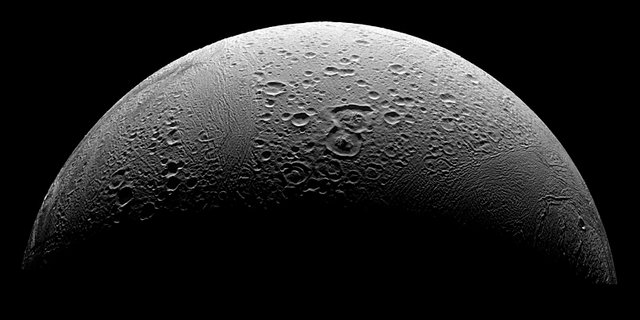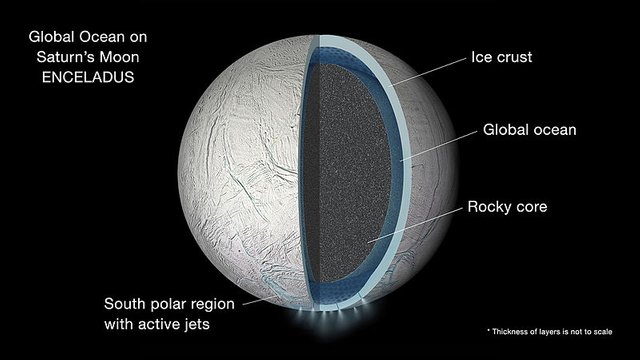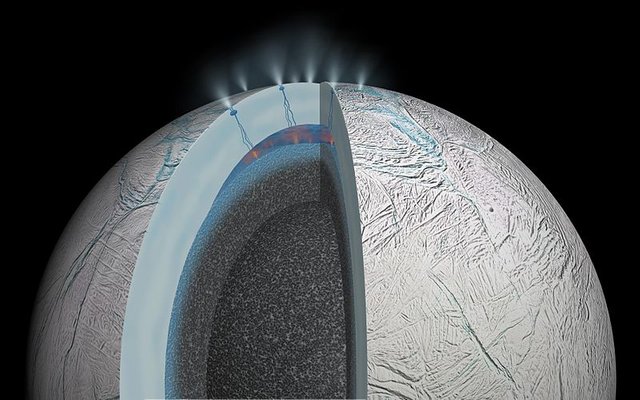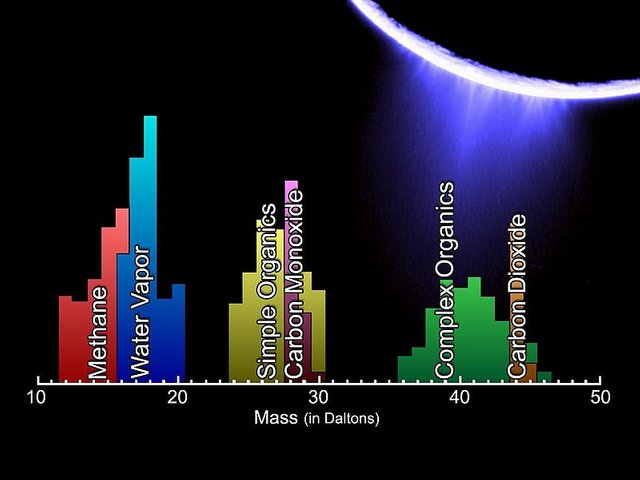The Brightest Object In our Solar System, That Might Have Life - Enceladus
Introduction
In one of my previous posts I wrote some weeks back about the discovery of water plumes in Europa, one of the Galilea moons that orbits Jupiter. Which is an incredible revelation, because it goes on to validate astronomers claim that the moon is submerged in a global ocean, that lies beneath its frozen surface. Quite frankly, it was an exciting news for the astronomy community, as it presents several opportunities on the frontiers of science. And NASA is already making plans to examine the moon, with the Europa Clipper Mission set to launch in the 2020's, with the hope analyzing water samples from this plume, and transmit the data back to Earth for further analysis of the plume's content. All this is in a bid to explore the possibilities of terrestrial life outside Earth.

Image - Wikimedia Commons (CC0)
But despite all the excitement that came with the plumes discovery in Europa, another moon, currently orbiting yet another Jovian planet; with a similar morphological structure as Europa, has already been spotted to possess subsurface ocean and massive plumes around its south pole regions of the moon. This moon is known as Enceladus. Enceladus is the brightest object in our solar system, and is characterized by having white surface, that is smooth in most of its area surface. This satellite has a lot of fascinating attributes, one of which is the discovery of chemical compounds that may suggest that there is the possibility of a habitable world on the satellite; and possibly be budding with life already. In this post, we will pay a visit one of Saturn’s moon - Enceladus.
About This Fascinating Moon
This small moon is only one-tenth in size when compared to Saturn's largest moon - Titan, and it is the 6th largest moon orbiting the Jovian planet. Marked by a covering of its clean icy surface, hence making it the most reflective object in the solar system. Its surface has a range of astonishing features that includes young, heavily cratered, old and a tectonically deformed terrain. This 500 kilometres diameter moon possesses an intriguing character that has drawn the whole scientific world to it, the presence of its plumes, we will talk about that in details later in this post.

View of Enceladus's orbit (highlighted in red) from above Saturn's north pole.
Image by The singing Badger - Wikimedia Commons (CC BY-SA 2.5)
Enceladus was discovered in 1789 by William Herschel when he started using his brand new 1.2m telescope, which at the time was the largest telescope the world had seen.
This magnificent moon got its name from the Greek mythology, same as the other Saturnian moons. It is one of the closest moons to Saturn and orbits its host star - Saturn every 32.9 hours making it one of the fastest moons among the other Saturnian moons.
This moon consists of a shining icy surface, as well as a rocky core, and in-between this rocky interior and the icy surface; lies what the moon is most popular for - water!
The Cassini spacecraft has observed vents of water escaping through the icy surface of the moon, into space. This plumes as they are known, escape through the cracks on the surface of the satellite located at the south pole region, and a portion of the pressurized water head to space, forming part of Saturns E-ring, and the other falls back the moon.
What’s up with its Plumes
Enceladus has been thought to be a barren giant cue ball orbiting Saturn until NASA’s Cassini captured images that suggest the satellite has a global ocean of water, as well as having active geysers, or you can call them plumes. This piece of information changed how the moon was looked at by the astronomy community, which led to the exploration of this shiny global ocean. This made astronomers believe that Enceladus either has life existing on the moon at a microscopic level or has what it takes to support it since water is one of the key ingredients of life.
The discovery of this plumes began in 2005 when astronomers observed plumes emitting water vapour into space from the south polar surface of the moon. About 552 pounds of water vapour at a speed of 1,360 mph is released into space every second. It was later established that the plumes of Enceladus are the origin of Saturn’s E-Ring; the ring which is composed of countless small particles, but it mostly consists of water ice and little traces of rock materials. It is still not clear how the E-ring was formed, but it is believed to have been formed in the early years when the solar system was formed.
Images have been captured of plumes or geysers emanating from Enceladus, these plumes have several implications, one way to look at it is as we mentioned earlier, they are the likely sources of the Saturn’s E ring. This largest ring system in our solar system, This diffuse disk is composed of dusty material disperse between the orbits of Titan and Mimas. With a lifespan of less than a million years, the E ring is said to be quite unstable and is composed of replenishable particles.
Regressing back to the plumes discussion, water samples of the plumes have been analysed by Cassini which has the necessary equipment to carry out such analysis, but details on this will be explored in the next paragraph. But just to offer a little hit on the composition of the plumes indicates that the plumes are salty in nature, which is a direct indicator that its source is the salty subsurface global ocean.
Possibility of Life on This Cue Ball World
Scientists suggested that chemical reactions between the rock on Enceladus and the water that lies beneath its icy surface, have the capacity to create adequate energy that can give rise to microbial life, and this has led scientist to start looking for proof of the possibility of the occurrence of the right reaction. And that chemical reaction has been found in the form of molecular hydrogen. This discovery made Enceladus a solar body with the capacity to sustain microbial life.
After NASA’s Cassini discovered the presence of geyser plumes on Enceladus, the spacecraft was tasked to fly straight through this plumes, in a bid to detect the chemical composition of the icy water. This instrument acts like the human nose which sniffs and smell the chemical composition of the environment. This time, the instrument also found traces of ammonia, methane, carbon dioxide, carbon monoxide, salts and other simple organic molecules
With the presence of all these chemical elements in the plumes, this shows that the ocean water has indeed had chemical reactions with the heated rock of Enceladus; which has made the water present at Enceladus richer in chemicals. So, the ocean water gets into the hot rocky core of Enceladus, gets heated, resulting in some chemical reactions and then escape back into the ocean through hydrothermal vents.
Although there was a missing proof of this said rock-water chemical reaction on Enceladus, and the missing piece was hydrogen molecule; which should be freed up as a by-product of the rock-water reactions. Finding this hydrogen becomes crucial in the search of a habitable environment that can support microbial life on Enceladus. And recent studies revealed that Cassini has detected hydrogen on Enceladus, this was achieved by a fly-by through a plume geyser, this was achieved by another Cassini flyby through the plume, this time the spacecraft was 120 km from the surface of Enceladus what flew straight through the plume at 8.5 km/s.
The discovery of hydrogen is very important reason being that its presence along with rock and hot water are sufficient to allow simple microorganisms to survive and make a living. When dissolved hydrogen reacts with dissolved carbon-dioxide, methane and water are produced; which in turn releases energy that promotes metabolism in microorganisms. With all these in place, it is believed that Enceladus has the required ingredients to support simple life, the only missing piece is life itself.
Future Exploration
The Enceladus Life Finder (ELF) is an astrobiology mission that proposes to assess Enceladus subsurface ocean in search if the satellite is habitable for life, and also search for the presence of existing life. The probe is planned to orbit Saturn, and then make a number of flybys right through the moon’s plumes in a bid to analyse the content of the satellite's subsurface ocean.
Although funding the mission has been overlooked twice, first in 2015 during the Discovery Mission and then in May 2017 during NASA's New Frontiers Program Mission 4.
Conclusion
Enceladus is a very small moon and the available energy and resources currently available won’t be sufficient to host complex life. On the other hand, the larger Europa seems to be a better prospect, it is almost the same size as Earth’s month, and if the Europa Clipper mission, which is scheduled to launch in the mid 2020’s stumbles across a habitable world, I believe it will be the choice destination for astrobiologist in the quest of discovering extraterrestrial life.
References
WIRED - If There's Life on Saturn's Moon
WIKIPEDIA - Enceladus Life Finder
The Conversation - Saturn's Moon Enceladus is able to host life






Please Upvote➜https://steemit.com/christianity/@bible.com/verse-of-the-day-revelation-21-8-niv
I really hope these places could be explored soon enough and see if they can have basic ways of life, I have been waiting for extraterrestrial life to be confirmed for years, and in my opinion it is just a matter of time for it to be officially announced.
You're absolutely right, its just a matter of time, before extraterrestrial life is found, who knows maybe alien life has been found and the government maybe be hiding it. I guess we'll never know, but as you said, its just a matter of time.
Thanks for the feedback.
Thanks for sharing another good post.
Solar exploration is always fascinating and still in its infancy.
There is so much to explore for future generations...
Absolutely!
Space is truly fascinating with so much to explore
Thanks for the feedback!
Hi @agbona!
Your post was upvoted by utopian.io in cooperation with steemstem - supporting knowledge, innovation and technological advancement on the Steem Blockchain.
Contribute to Open Source with utopian.io
Learn how to contribute on our website and join the new open source economy.
Want to chat? Join the Utopian Community on Discord https://discord.gg/h52nFrV